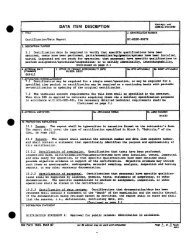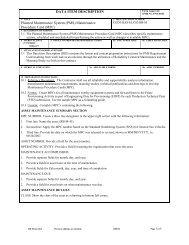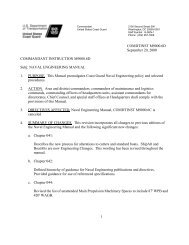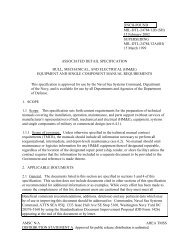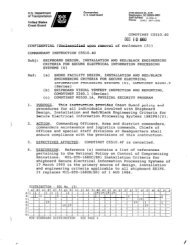comdtinst m2400.1f - US Coast Guard Response Boat-Medium
comdtinst m2400.1f - US Coast Guard Response Boat-Medium
comdtinst m2400.1f - US Coast Guard Response Boat-Medium
Create successful ePaper yourself
Turn your PDF publications into a flip-book with our unique Google optimized e-Paper software.
CHAPTER 4. RADIO FREQUENCY MANAGEMENT AUTHORITY AND PROCEDURES<br />
A. General.<br />
1. Frequency Spectrum. The radio frequency spectrum is a imited resource<br />
that must accommodate a multiplicity of telecommunication<br />
requirements. Unrestricted use of radio frequencies would result in<br />
disrupted communications and harmful interference between radio<br />
systems. Frequency management organizations have been established on<br />
the international and national level to allocate frequency bands to<br />
specific services, develop regulations for the orderly use of<br />
frequencies and issue frequency assignments to individual users.<br />
2. Organizations. Internationally, radio frequencies are allocated and<br />
managed by the International Telecommunications Union (ITU), an<br />
organization under the United Nations. Nationally, radio frequencies<br />
are managed by the National Telecommunications and Information<br />
Administration (NTIA) for federal government usage and by the Federal<br />
Communications Commission (FCC) for non-federal government use.<br />
3. NTIA. NTIA is assisted in the management of the radio spectrum by the<br />
Interdepartment Radio Advisory Committee (IRAC). This committee is<br />
comprised of representatives from the departments and agencies of the<br />
federal government that use the radio spectrum. The IRAC has<br />
established four subcommittees to develop and recommend radio policy<br />
and assign radio frequencies to federal agencies:<br />
(a) Frequency Assignment Subcommittee (FAS)<br />
(b) Spectrum Planning Subcommittee (SPS)<br />
(c) Technical Subcommittee (TSC)<br />
(d) International Notification Group (ING)<br />
4. FCC. The FCC develops radio policy and assigns radio<br />
frequencies to all non-federal government agencies and the<br />
private sector. The FCC provides a liaison representative to<br />
the IRAC for coordinating non government requirements.<br />
5. JFP. The Joint Frequency Panel (JFP) of the Military<br />
Communications-Electronics Board (MCEB), under the Joint<br />
Chiefs of Staff (JCS), determines radio policy and assigns<br />
radio frequencies to the military departments for operations<br />
outside the United States and Possessions.<br />
6. <strong>Coast</strong> <strong>Guard</strong>. <strong>Coast</strong> <strong>Guard</strong> radio frequency management is the<br />
responsibility of the Maritime Radio and Spectrum Management<br />
Division (G-TTM), Office of Command, Control and<br />
Communications (G-T), <strong>Coast</strong> <strong>Guard</strong> Headquarters. The<br />
Maritime Radio and Spectrum Management Division provides<br />
representatives to the IRAC, its subcommittees and the JFP.<br />
They provide official liaison for the Commandant with the FCC<br />
and NTIA. The <strong>Coast</strong> <strong>Guard</strong> also provides frequency management<br />
support for the Department of Transportation (except<br />
4-1





